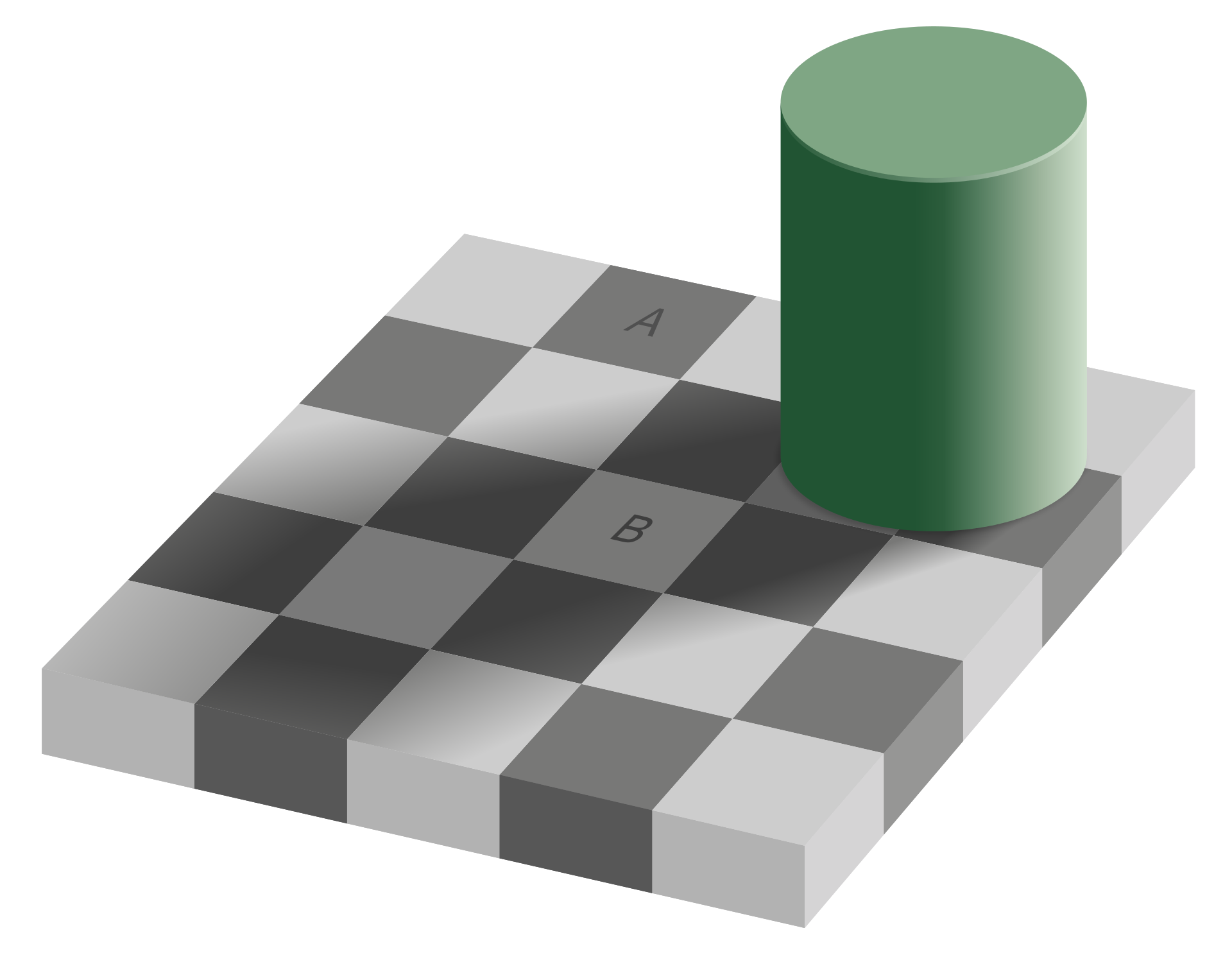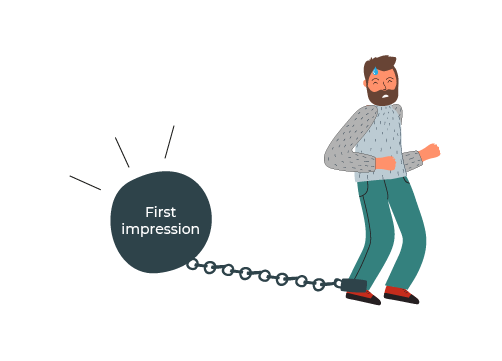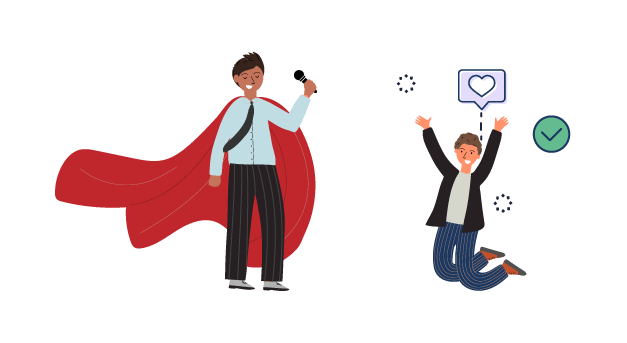Adelson's Chessboard Illusion
Try this test to help you understand cognitive bias. Look at the chessboard below, designed by MIT (Massachusetts Institute of Technology) researcher Adelson.

What colors are the A and B squares? Are they different?
Answer: In fact, the A and B squares are the same color! Your perception and reality differ. Why do they seem like different shades? Because your eye is fooled by the shadow of the green cylinder on square B. It automatically corrects and brightens it.
Explanations: When you look at this image, you don't interpret it in isolation, but with the knowledge you already have about the world. You know that the standard chessboard has alternating light and dark squares so your brain standardizes what you see. It then compensates for light variations to re-create what you already know about a chessboard. It's called the color constancy phenomenon. It can make life easier, but it can also lead you astray.
Your brain plays tricks on you and fools your perception, as you've likely seen in other optical illusions. But it can also lead to bias in your interpretations or judgments.
The Origin of Cognitive Biases
Every day you're bombarded with information that your brain must perceive, analyze, sort, and retain. It's hard work and, as mentioned earlier in the course, your brain doesn’t like it.
That’s when heuristics take over!
These shortcuts meet four major needs:
Knowing how to sort all the information you receive.
Identifying what you need (or don't need) to remember.
Acting quickly.
Making sense of what is going on around you.
However, they can also lead to distortions and errors of judgment, which are cognitive biases.
Is it possible to avoid cognitive biases? How can you deal with them? We asked Marcia Goggard to explain:
It's Your Turn

To make the notion of cognitive bias more concrete, try this activity.
What color is a bone?
What color is snow?
What color is a cloud?
What color is paper?
What color is Henry IV's white horse?
You'll answer white to each question.
So right after I ask you:
What does a cow drink?
You'll probably answer "milk" even though you know that cows drink water. 🙈 What happened in your brain? 😱 The first set of questions focused your thinking on the color white. When you had to quickly answer the last question, you thought of the first white liquid that came to mind: milk. This automatic brain response is a cognitive bias, a quick and short path that's not necessarily the best.
In the face of danger or an emergency, your brain prefers to act quickly instead of analyzing the situation further. These mental shortcuts can lead to a suitable solution - or an incorrect conclusion.
OK, but shouldn't I listen to my intuition? How can I do that if my brain plays tricks on me?
It's important to listen to your intuition, but not rely solely on it. The world is complex. Sometimes your intuition is very useful; it's what allows you to make quick and often effective decisions. On the other hand, it's essential to take the time to study the data to avoid cognitive biases in uncertain situations.
Analyze a Professional Situation
Which cognitive biases have you identified in the video? Select three:
Confirmation bias: favoring information that confirms your beliefs.
Optimism bias: seeing only the bright side of things.
Retrospective bias: rationalizing an unforeseeable event after the fact ("I knew it from the start").
Status quo bias: resisting change, preferring inertia.
Framing bias: being influenced by the form to the detriment of the content.
The overconfidence effect: being too confident about your actual mastery of a subject.
Authority bias: thinking that the leader is always right.
Anchoring bias: the tendency to stick to the initial information.
Decided on your answers? Let's check if you're right. The three biases at work here are confirmation bias, authority bias, and anchoring bias. Let's now look at each of these in more detail.
Proving Yourself Right With The Confirmation Bias

The phrase "We believe what we want to" perfectly illustrates confirmation bias. Have you ever consulted an article or a book to find information that specifically confirms your opinion? Confirmation bias supports the story you create mentally. People give more importance to the information or signs that support their decision and validate their goals or beliefs.
When you fall into this bias, you:
Subjectively direct the search for information.
Look at the question from one angle.
Suppress alternatives that lead to other solutions.
In Emma's situation, when does the confirmation bias appear?
It appears when she looked for information that confirmed her desire to become a UX designer. The magazine 20 Minutes likely included other advertisements, but Emma focused on the one promoting UX design training. The same goes for TV news.
Here's another example. You've noticed that your supervisor hasn't come to your office to greet you for a week. You've decided that he's avoiding you. Or, you believe that he prefers another colleague who he'll promote or offer his new project to instead of you. You'll invariably look for evidence to justify your beliefs and will interpret each fact or gesture as reinforcing the story you've created.
How can you tame this cognitive bias?
To overcome this bias, you need to look for evidence that contradicts your belief. Which means, you'll need to apply a more scientific approach.
Use the VALID acronym to avoid making a decision that simply confirms your original opinion:
Value all sources of information.
Alert those in your entourage to share various opinions.
Let go and suspend your judgment.
Inspect the project from A to Z.
Decide to emphasize objectivity.
Holding on to First Impressions with The Anchoring Bias

Anchoring bias describes the difficulty associated with letting go of a first impression. The brain clings to initial information and doesn't budge. This information remains anchored in your memory and unconscious. By retaining this initial information, the mind can no longer appreciate and consider new knowledge or envisage alternatives. Similarly, your mind will be hard-pressed to let go of your first impression of someone.
In Emma's situation, when does the anchoring bias appear?
It appears when her manager announces his new target numbers: Emma focuses on the outrageous figure and sees her situation through that lens, telling herself that she'll never reach it.
Other examples:
You're attending an important meeting to mark the launch of a new project. You don't know the participants. The employee who's leading the meeting arrives late. You'll tend to remember her as an unreliable person, even though this event is not representative of her usual professionalism.
During salary negotiations, you ask for a raise. You decide the figure you first asked for is too low and suggest a higher amount. The negotiation comes to an end because your manager focused on the first amount you offered and wouldn't budge.
How can you deal with this cognitive bias?
Use the ANCOR acronym to avoid making decisions based on a first impression:
Avoid rushing to interpret, instead make judgments based on intrinsic value.
Never stop at the initial information received.
Collect more information before making a decision.
Overlook, in principle, the initial information.
Reflect on reversing this bias by using other points of comparison.
Believing in Authority Figures with The Authority Bias

Authority bias comes from the belief that the boss is always right or the fear of contradicting an expert or an authority figure. This bias can prevent you from expressing your point of view.
In Emma's situation, when does the authority bias appear?
It appears in Emma's interaction with her parents: she changes her mind immediately after her parents oppose her retraining plan.
I'll give you other examples:
You work in a company where your supervisors are highly-respected IT experts and whose level of skill far outweighs yours. When you disagree with their decision-making you choose not to say anything. Instead, you agree with them, even when it concerns broader aspects that fall outside the area of pure computing - ethical considerations, for example.
None of the European experts predicted the sub-prime crisis. People tended to overvalue expert opinions despite the economic signals in 2005 and 2006. They gave more authority to these opinions instead of the signs that alerted people to the crisis.
How can you deal with this cognitive bias?
Use the COACH acronym to avoid constantly endorsing the opinion of the person in authority:
Call your superiors to discuss the matter.
Offer them a moment to explain their thoughts.
Argue methodically and confidently.
Consider that the single line of thought does not advance things.
Heighten your position by trusting in your own opinion.
Emma can take inspiration from the H of the COACH acronym by working on her approach when talking to her supervisor by sharing her opinion as an equal. In this way she'll be perceived as a key negotiating partner who is prepared to confront authority and offer her opinion.
Let's Recap!
In this chapter, you discovered that:
Heuristics are shortcuts that the brain uses to make decisions quickly and efficiently. Most of the time, they're extremely useful.
Cognitive biases are a subset of heuristics: they're misleading shortcuts.
Confirmation bias is the act of selecting only information and data that confirm the beliefs you've already formed. To tame it, push yourself to look for information that proves the opposite of what you believe.
Anchoring bias consists of staying focused on the initial information received. To get rid of it, you can do more research and rely on other points of comparison before reaching a decision.
Authority bias involves aligning yourself to the opinion of experts or people in authority. To deal with this bias, trust yourself, learn to argue, and discuss the issue calmly with the other party.
You have discovered how cognitive biases can alter your decision-making. You now have all the keys in hand to act. In the next part of the course, I invite you to take ownership of the proven methods to make decisions effectively.
